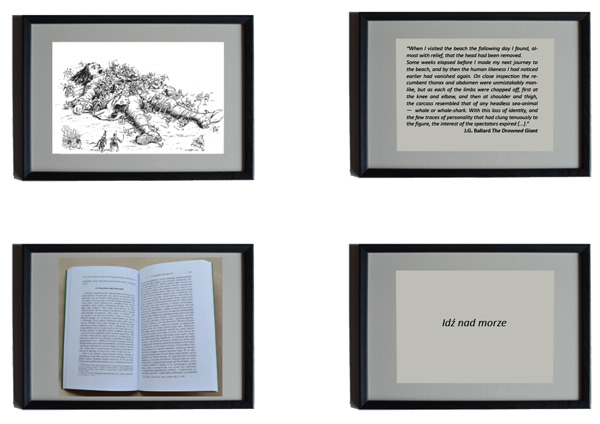TRZECIE NARZĘDZIE ROZPOZNANIA: MORZE
THE THIRD TOOL OF RECOGNITION: SEA
“When I visited the beach the following day I found, almost with relief,
that the head had been removed.
Some weeks elapsed before I made my next journey to the beach, and
by then the human likeness I had noticed earlier had vanished again. On
close inspection the recumbent thorax and abdomen were unmistakably
manlike, but as each of the limbs were chopped off, first at the knee and
elbow, and then at shoulder and thigh, the carcass resembled that of any
headless sea-animal — whale or whale-shark. With this loss of identity,
and the few traces of personality that had clung tenuously to the figure,
the interest of the spectators expired (...).”
J.G. Ballard The Drowned Giant
O MORZU:
* Nierozpoznanie i odrzucanie
Morze wyrzuca na brzeg wszystko co dostanie się w jego obszar – wszystko,
co ma w sobie ale nie rozpoznaje jako swoje.
Pozbywa się więc wszystkiego, co jest innego rodzaju, nie przynależy do
niego, co jest właśnie obce.
* Granica terytorium i przestrzeń korespondencji
Morze (tak jak ocean czy rzeki) jest naturalną granicą terytorium, na którym
żyjemy; jest tym samym granicą z tym co jest obce i inne.
Jest (neutralną?) przestrzenią pomiędzy nami i innymi.
Jest też przestrzenią w pewnym sensie aktywną, która koresponduje
pomiędzy różnymi obszarami.
* Przedmioty badań
Morze wyrzucając obce na brzeg dostarcza nam swoistego „materiału do
badań”, który nie jest dla nas obojętny. Wymaga tego aby się do niego
ustosunkować, porównać się, ocenić i może nawet ocenić się względem
niego.
Opis techniczny:
Narzędzie składa się z 4 elementów:
Ilustracji – 1. / opisu – 2. / instrukcji – 3. / polecenia – 4.
1. Kopia ilustracji: Lemuel Gulliver, set ashore after a mutiny, regains consciousness to find himself trapped by the Lilliputians, from E. C. Broch’s drawing in an 1894 edition of Jonathan Swift’s Gulliver’s Travels
2. Przytoczony na wstępie fragment opowiadania J.G. Ballarda The Drowned Giant
3. Zdjęcie rozkładówki z książki Bernharda Waldensa Podstawowe motywy fenomentologii obcego rozdział: Inny jako mój sobowtór
4. Polecenie: Idź nad morze
